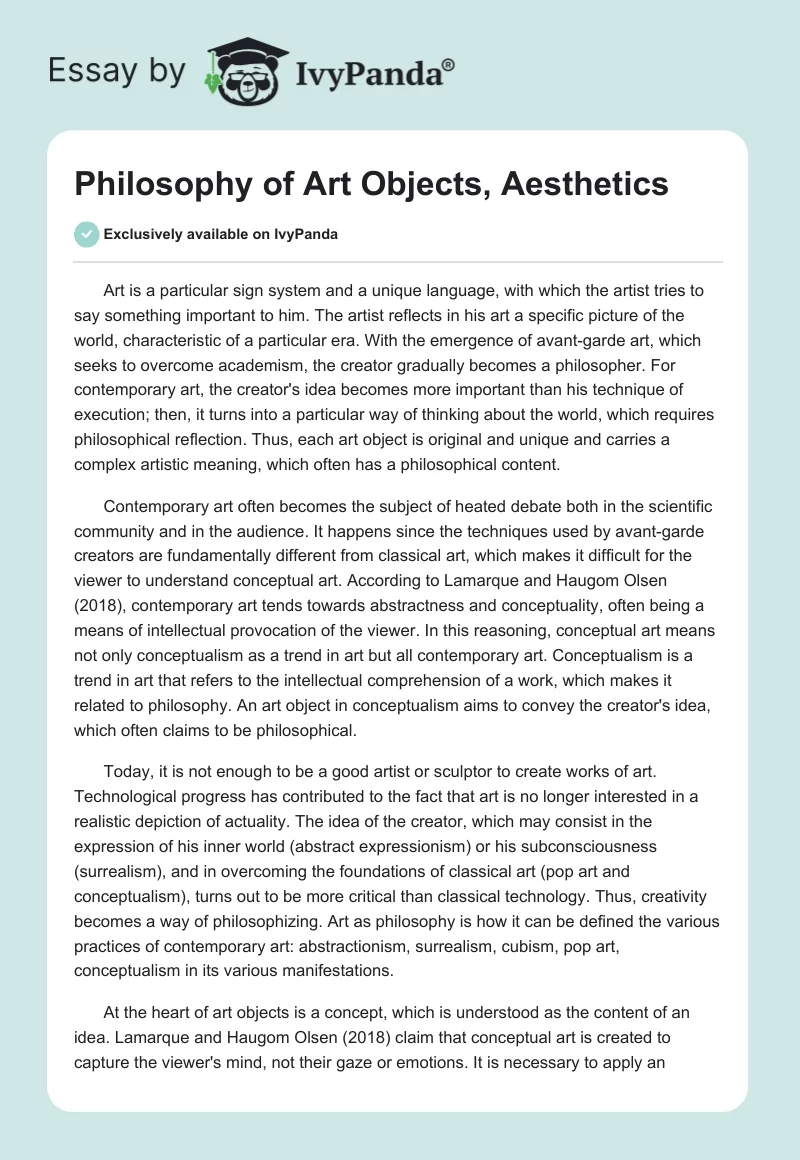Art is a particular sign system and a unique language, with which the artist tries to say something important to him. The artist reflects in his art a specific picture of the world, characteristic of a particular era. With the emergence of avant-garde art, which seeks to overcome academism, the creator gradually becomes a philosopher. For contemporary art, the creator’s idea becomes more important than his technique of execution; then, it turns into a particular way of thinking about the world, which requires philosophical reflection. Thus, each art object is original and unique and carries a complex artistic meaning, which often has a philosophical content.
Contemporary art often becomes the subject of heated debate both in the scientific community and in the audience. It happens since the techniques used by avant-garde creators are fundamentally different from classical art, which makes it difficult for the viewer to understand conceptual art. According to Lamarque and Haugom Olsen (2018), contemporary art tends towards abstractness and conceptuality, often being a means of intellectual provocation of the viewer. In this reasoning, conceptual art means not only conceptualism as a trend in art but all contemporary art. Conceptualism is a trend in art that refers to the intellectual comprehension of a work, which makes it related to philosophy. An art object in conceptualism aims to convey the creator’s idea, which often claims to be philosophical.
Today, it is not enough to be a good artist or sculptor to create works of art. Technological progress has contributed to the fact that art is no longer interested in a realistic depiction of actuality. The idea of the creator, which may consist in the expression of his inner world (abstract expressionism) or his subconsciousness (surrealism), and in overcoming the foundations of classical art (pop art and conceptualism), turns out to be more critical than classical technology. Thus, creativity becomes a way of philosophizing. Art as philosophy is how it can be defined the various practices of contemporary art: abstractionism, surrealism, cubism, pop art, conceptualism in its various manifestations.
At the heart of art objects is a concept, which is understood as the content of an idea. Lamarque and Haugom Olsen (2018) claim that conceptual art is created to capture the viewer’s mind, not their gaze or emotions. It is necessary to apply an intellectual effort to perceive modern art objects and do a hermeneutic analysis, updating all your cultural and existential experiences.
Art objects are closely related to philosophy, which is confirmed by similarities with existentialism and psychoanalysis. Death, the futility of human efforts, alienation of people from each other, and a state of anxious loneliness are the main existential motives that can be traced in many art objects. Furthermore, many surrealist art objects reflect the truth about a person, his monstrosity, without correcting or morally condemning it. Harman (2019) notes that it is a programmatic thesis of surrealism, the philosophical source of which is psychoanalysis. Such art objects show the spontaneous expression of the inner world and subconsciousness in chaotic forms, not organized by logical thinking.
As follows from the above, conceptual art should be viewed as a way of visual philosophizing, in which art approaches philosophy. In the case of visual philosophizing, we are talking about philosophizing through visual images or concepts. A work of conceptual art assumes that it is based on a philosophical meaning or idea that needs to be interpreted. Philosophers comprehend the world with philosophical concepts, but art workers can also think in concepts. Those and others are brought together by one goal – the knowledge of reality.
Works Cited
Harman, Graham. Art and Objects. Wiley, 2019.
Lamarque, Peter and Stein Haugom Olsen. Aesthetics and the Philosophy of Art: The Analytic Tradition, An Anthology. 2nd ed., Wiley, 2018.


